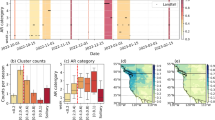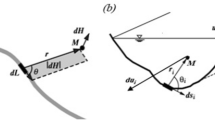Abstract
This study introduces a new complex networks-based method to examine the spatio-temporal connections in streamflow. The method involves reconstruction of two (or more) time series jointly in a multi-dimensional phase space using a nonlinear phase space embedding procedure and construction of the spatio-temporal streamflow network of nodes and links based on the reconstructed vectors. After this spatio-temporal network construction, the clustering property of the network is measured using the clustering coefficient, which quantifies the tendency of a network to cluster. The approach is applied to monthly streamflow time series observed at each of 639 streamflow stations in the United States. Different distance threshold values are used to identify the presence/absence of links in the streamflow network and, hence, to calculate the clustering coefficient. The clustering coefficient results help to identify the critical distance threshold and optimal embedding dimension of each streamflow time series using different distance threshold values. The optimal embedding dimensions and the clustering coefficient values of the 639 streamflow time series are also discussed in terms of the role of catchment and flow properties (drainage area, elevation, flow mean, and flow coefficient of variation). The dimensions for the 639 streamflow time series are generally found to range from 2 to 18 (but even up to 30 for a few stations), indicating a wide range of complexity in the spatio-temporal connections in streamflow across the United States. The clustering coefficient values for the 639 stations are found to be in the range of 0.53–0.99, which suggest generally strong connections. The outcomes of this study clearly indicate the usefulness of the networks-based approach for examining the spatio-temporal connections in streamflow.











Similar content being viewed by others
Availability of data and material
The streamflow data used in this study are from the US Geological Survey (USGS) database for surface water (https://nwis.waterdata.usgs.gov/nwis/sw), and specifically from the Hydro-Climatic Data Network (HCDN). The data may be obtained from the authors upon request.
Code availability
The code may be obtained from the authors upon request.
References
Agarwal A, Marwan N, Maheswaran R, Ozturk U, Kurths J, Merz B (2020) Optimal design of hydrometric station networks based on complex network analysis. Hydrol Earth Syst Sci 24(5):2235–2251
Alarcòn RR, Lozano S (2019) A complex network analysis of Spanish river basins. J Hydrol 578:124065
Barabási A-L, Albert R (1999) Emergence of scaling in random networks. Science 286:509–512
Berndtsson R, Jinno K, Kawamura A, Olsson J, Xu S (1994) Dynamical systems theory applied to long-term temperature and precipitation time series. Trends Hydrol 1:291–297
Braga AC et al (2016) Characterization of river flow fluctuations via horizontal visibility graphs. Physica A 444:1003–1011. https://doi.org/10.1016/j.physa.2015.10.102
Fang K, Sivakumar B, Woldemeskel FM (2017) Complex networks, community structure, and catchment classification in a large-scale river basin. J Hydrol 545:478–493. https://doi.org/10.1016/j.jhydrol.2016.11.056
Fraser AM, Swinney HL (1986) Independent coordinates for strange attractors from mutual information. Phys Rev A 33(2):1134–1140
Halverson MJ, Fleming SW (2015) Complex network theory, streamflow, and hydrometric monitoring system design. Hydrol Earth Syst Sci 19(7):3301–3318. https://doi.org/10.5194/hess-19-3301-2015
Han X, Sivakumar B, Woldmeskel FM, Guerra de Aguilar M (2018) Temporal dynamics of streamflow: application of complex networks. Geosci Lett 5(1). https://doi.org/10.1186/s40562-018-0109-8
Han X, Ouarda TBMJ, Rahman A, Haddad K, Mehrotra R, Sharma A (2020) A network approach for delineating homogeneous regions in flood frequency analysis. Water Resour Res 56(3):e2019WR025910.
Holzfuss J, Mayer-Kress G (1986) An approach to error-estimation in the application of dimension algorithms. In: Mayer-Kress G (ed) Dimensions and entropies in chaotic systems. Springer, New York, pp 114–122
Istalkar P, Unnithan SLK, Biswal B, Sivakumar B (2021) A Canberra distance-based complex network classification framework using lumped catchment characteristics. Environ Res Risk Assess. https://doi.org/10.1007/s00477-020-01952-4
Jha SK, Sivakumar B (2017) Complex networks for rainfall modeling: Spatial connections, temporal scale, and network size. J Hydrol 554:482–489
Joo H, Lee M, Kim J, Jung J, Kwak J, Kim HS (2021) Stream gauge network grouping analysis using community detection. Stoch Environ Res Risk Assess 35(4):781–795
Kammerer JC (1990) Largest Rivers in the United States, US Geological Survey Fact Sheet, Open File Report 87-242.
Kiang JE, Stewart DW, Archfield SA, Osborne EB, Eng K (2013) A national streamflow network gap analysis. US Geological Survey Scientific Investigations Report 2013–5013, Reston, Virginia, USA.
Konapala G, Mishra A (2017) Review of complex networks application in hydroclimatic extremes with an implementation to characterize spatio-temporal drought propagation in continental USA. J Hydrol 555:600–620. https://doi.org/10.1016/j.jhydrol.2017.10.033
Liebert W, Schuster HG (1989) Proper choice of the time delay for the analysis of chaotic time series. Phys Lett A 141:386–390
Lins HF (2012) USGS Hydro-climatic data network 2009 (HCDN–2009). US Geological Survey Fact Sheet 2012–3047, US Geological Survey, Reston, VA, USA.
Naufan I, Sivakumar B, Woldemeskel FM, Raghavan SV, Vu MT, Liong SY (2018) Spatial connections in regional climate model rainfall outputs at different temporal scales: Application of network theory. J Hydrol 556:1232–1243
Packard NH, Crutchfield JD, Farmer JD, Shaw RS (1980) Geometry from a time series. Phys Rev Lett 45(9):712–716
Serinaldi F, Kilsby CG (2016) Irreversibility and complex network behavior of stream flow fluctuations. Physica A 450:585–600. https://doi.org/10.1016/j.physa.2016.01.043
Sivakumar B (2003) Forecasting monthly streamflow dynamics in the western United States: a nonlinear dynamical approach. Environ Modell Softw 18:721–728
Sivakumar B (2017) Chaos in Hydrology: Bridging determinism and stochasticity. Springer, The Netherlands
Sivakumar B, Woldemeskel FM (2014) Complex networks for streamflow dynamics. Hydrol Earth Syst Sci 18(11):4565–4578
Sivakumar B, Woldemeskel FM (2015) A network-based analysis of spatial rainfall connections. Environ Model Softw 69:55–62
Sivakumar B, Singh VP (2012) Hydrologic system complexity and nonlinear dynamic concepts for a catchment classification framework. Hydrol Earth Syst Sci 16(11):4119–4131. https://doi.org/10.5194/hess-16-4119-2012
Sivakumar B, Sorooshian S, Gupta HV, Gao X (2001) A chaotic approach to rainfall disaggregation. Water Resour Res 37(1):61–72
Slack JR, Landwehr VM (1992) Hydro Climatic Data Network (HCDN): a US Geological Survey streamflow data set for United States for the study of climate variations, 1847–1988. US Geological Survey Open File Report, 92–129.
Takens F (1981) Detecting strange attractors in turbulence. In: Rand DA, Young LS (eds) Dynamical systems and turbulence, vol 898. Lecture Notes in MathematicsSpringer-Verlag. Berlin, Germany, pp 366–381
Tiwari S, Jha SK, Sivakumar B (2019) Reconstruction of daily rainfall data using the concepts of networks: Accounting for spatial connections in neighborhood selection. J Hydrol 579:124185
Tongal H, Demirel MC, Booij MJ (2013) Seasonality of low flows and dominant processes in the Rhine River. Stoch Environ Res Risk Assess 27:489–503
Tumiran SA, Sivakumar B (2021a) Catchment classification using community structure concept: application to two large regions. Environ. Res. Risk Assess, Stoch. https://doi.org/10.1007/s00477-020-01936-4
Tumiran SA, Sivakumar B (2021b) Community structure concept for catchment classification: a modularity density-based edge betweenness (MDEB) method. Ecol Ind 124:107346
Vignesh R, Jothiprakash V, Sivakumar B (2015) Streamflow variability and classification using false nearest neighbor method. J Hydrol 531:706–715
Watts DJ, Strogatz SH (1998) Collective dynamics of “small-world” networks. Nature 393:440–442
Yasmin N, Sivakumar B (2018) Temporal streamflow analysis: coupling nonlinear dynamics with complex networks. J Hydrol 564:59–67
Yasmin N, Sivakumar B (2021) Study of temporal streamflow dynamics with complex networks: network construction and clustering. Stoch Env Res Risk Assess. https://doi.org/10.1007/s00477-020-01931-9
Acknowledgments
The authors thank the two reviewers and the Associate Editor for their constructive comments and usefulness suggestions on an earlier version of this manuscript, which led to significant improvements to the quality and presentation of the work.
Funding
This study was supported by the Australian Research Council (ARC) Future Fellowship Grant (FT110100328). Bellie Sivakumar acknowledges the financial support from ARC through this Future Fellowship Grant. Nazly Yasmin acknowledges the financial support of the Australian Post Graduate Award (University of New South Wales).
Author information
Authors and Affiliations
Corresponding author
Ethics declarations
Conflict of interest
The authors declare no conflict of interest/competing interests.
Additional information
Publisher's Note
Springer Nature remains neutral with regard to jurisdictional claims in published maps and institutional affiliations.
Rights and permissions
About this article
Cite this article
Yasmin, N., Sivakumar, B. Spatio-temporal connections in streamflow: a complex networks-based approach. Stoch Environ Res Risk Assess 35, 2375–2390 (2021). https://doi.org/10.1007/s00477-021-02022-z
Accepted:
Published:
Issue Date:
DOI: https://doi.org/10.1007/s00477-021-02022-z




